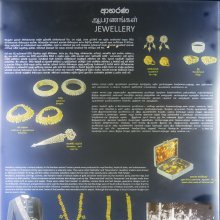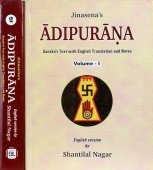Nami, Nāmi: 19 definitions
Introduction:
Nami means something in Hinduism, Sanskrit, Jainism, Prakrit, Buddhism, Pali, Marathi, Hindi, Tamil. If you want to know the exact meaning, history, etymology or English translation of this term then check out the descriptions on this page. Add your comment or reference to a book if you want to contribute to this summary article.
Images (photo gallery)
In Hinduism
Vaishnavism (Vaishava dharma)
Source: Pure Bhakti: Bhajana-rahasya - 2nd EditionNāmī (नामी) refers to:—The Supreme Lord, Śrī Bhagavān; the person addressed by the holy name. (cf. Glossary page from Bhajana-Rahasya).
Source: Pure Bhakti: Brhad BhagavatamrtamNāmī (नामी) refers to:—Śrī Bhagavān; the person addressed by the name. (cf. Glossary page from Śrī Bṛhad-bhāgavatāmṛta).

Vaishnava (वैष्णव, vaiṣṇava) or vaishnavism (vaiṣṇavism) represents a tradition of Hinduism worshipping Vishnu as the supreme Lord. Similar to the Shaktism and Shaivism traditions, Vaishnavism also developed as an individual movement, famous for its exposition of the dashavatara (‘ten avatars of Vishnu’).
In Jainism
General definition (in Jainism)
Source: Wisdom Library: JainismNami (नमि):—The twenty-first Tīrthaṅkara (Janism recognizes 24 such teachers or Siddhas). He is also known by the name Naminātha. His colour is gold (kāñcana), according to Aparājitapṛcchā (221.5-7). His height is 15 dhanuṣa (a single dhanuṣa (or, ‘bow’) equals 6 ft), thus, roughly corresponding to 27 meters. His emblem, or symbol, is a Blue lotus.
Nami’s father is Vijaya and his mother is Vaprā according to Śvetāmbara or Viprītā according to Digambara. It is an ancient Jain practice to worship the Tīrthaṅkara’s parents in various rites, such as the pratiṣṭhāvidhi, according to the Ācāradinakara (14th century work on Jain conduct written by Vardhamāna Sūri).
Source: archive.org: Trisastisalakapurusacaritra1) Nami (नमि) [also Nemi?] refers to the twenty-first of the twenty-four Tīrthaṅkaras praised in the first book (ādīśvara-caritra) [chapter 1] of Hemacandra’s 11th century Triṣaṣṭiśalākāpuruṣacaritra: an ancient Sanskrit epic poem narrating the history and legends of sixty-three illustrious persons in Jainism.
Accordingly, “[...] we worship the Arhats, who at all times and all places purify the people of the three worlds by their name, representation, substance, and actual existence. [...] May the rays of light from Nemi’s [Nami’s] toe-nails which, falling on the heads of his worshippers, purify them like streams of water, protect you”.
Nami is the son of Vaprā and Vijaya, according to chapter 1.6, “[...] In Bharata there will be twenty-three other Arhats and eleven other Cakrins. [...] In Mithilā, Nami, the son of Vaprā and Vijaya, gold-color, with a life of ten thousand years, fifteen bows tall, will have the vow for two thousand five hundred years, and the interval between Muni’s and Nami’s mokṣa will be six lacs of years”.
2) Nami (नमि) is the son of king Kaccha (one of the four-thousand kings who took initiation together with Ṛṣabha), according to chapter 1.3 [ādīśvara-caritra] of Hemacandra’s 11th century Triṣaṣṭiśalākāpuruṣacaritra: an ancient Sanskrit epic poem narrating the history and legends of sixty-three illustrious persons in Jainism.
Accordingly, “[...] now, the sons of Kaccha and Mahākaccha, Nami and Vinami by name, men of good training, had gone previously to distant foreign countries at the Master’s command. [...] Saying, ‘We too shall ask the Master, for a share of the earth’, Nami and Vinami approached the Master. Thinking, ‘He is free from worldly attachment’, not knowing that the Lord was engaged in pratimā, bowing, both spoke as follows: ‘...’.”.
Source: academia.edu: Tessitori Collection INami (नमि) or Namikumāra refers to one of the sons of Maiṇarehā (=Madanarekhā) and Jagabāhu, according to the “Madanarekhā satī no saṃbaṃdha” (dealing with the lives of Jain female heroes), which is included in the collection of manuscripts at the ‘Vincenzo Joppi’ library, collected by Luigi Pio Tessitori during his visit to Rajasthan between 1914 and 1919.—(Cf. Maiṃṇarehā)—[...] in Mathurā, Maiṇarehā became a nun. She came to know that her baby had been rescued by Padmaratha, king of Mithila and was called Namikumāra (97). As to Maiṇarehā’s and Jagabāhu’s elder son, Caṃdajasa (later called Jagabalabha), he had succeeded Maṇiratha who died from a snake bite (99). Padmaratha took religious initiation and was succeeded by Namikumāra. As a nun, Maiṇarehā had to intervene and to explain to the two kings, who wanted to fight about an elephant, that they were brothers and that she was their mother (125). [...]

Jainism is an Indian religion of Dharma whose doctrine revolves around harmlessness (ahimsa) towards every living being. The two major branches (Digambara and Svetambara) of Jainism stimulate self-control (or, shramana, ‘self-reliance’) and spiritual development through a path of peace for the soul to progess to the ultimate goal.
Languages of India and abroad
Pali-English dictionary
Source: BuddhaSasana: Concise Pali-English Dictionarynami : (aor. of namati) bent; bowed down.

Pali is the language of the Tipiṭaka, which is the sacred canon of Theravāda Buddhism and contains much of the Buddha’s speech. Closeley related to Sanskrit, both languages are used interchangeably between religions.
Marathi-English dictionary
Source: DDSA: The Molesworth Marathi and English Dictionarynāmī (नामी).—a (nāma) Celebrated for excellence; fine, good, superb, capital, surpassing. Used freely.
Source: DDSA: The Aryabhusan school dictionary, Marathi-Englishnāmī (नामी).—a Fine, superb, capital. Used freely.
Marathi is an Indo-European language having over 70 million native speakers people in (predominantly) Maharashtra India. Marathi, like many other Indo-Aryan languages, evolved from early forms of Prakrit, which itself is a subset of Sanskrit, one of the most ancient languages of the world.
Sanskrit dictionary
Source: DDSA: The practical Sanskrit-English dictionaryNāmi (नामि).—An epithet of Viṣṇu.
Derivable forms: nāmiḥ (नामिः).
Source: Cologne Digital Sanskrit Dictionaries: Aufrecht Catalogus CatalogorumNami (नमि) as mentioned in Aufrecht’s Catalogus Catalogorum:—a Śvetāmbara, pupil of Śālibhadra, composed in 1069:
—[commentary] on Rudraṭa’s Kāvyālaṃkāra.
1) Nami (नमि):—m. Name of a, [Jaina literature] author (1069), [Catalogue(s)]
2) Namī (नमी):—n. Name of a man, [Ṛg-veda]
3) Nāmi (नामि):—m. Name of Viṣṇu, [cf. Lexicographers, esp. such as amarasiṃha, halāyudha, hemacandra, etc.]
Source: DDSA: Paia-sadda-mahannavo; a comprehensive Prakrit Hindi dictionary (S)Nami (नमि) in the Sanskrit language is related to the Prakrit word: Ṇami.
[Sanskrit to German]
Sanskrit, also spelled संस्कृतम् (saṃskṛtam), is an ancient language of India commonly seen as the grandmother of the Indo-European language family (even English!). Closely allied with Prakrit and Pali, Sanskrit is more exhaustive in both grammar and terms and has the most extensive collection of literature in the world, greatly surpassing its sister-languages Greek and Latin.
Hindi dictionary
Source: DDSA: A practical Hindi-English dictionaryNāmī (नामी):—(a) famous, reputed, renowned, eminent; named, bearing the name (of); -[girāmī] famous, reputed, eminent.
...
Prakrit-English dictionary
Source: DDSA: Paia-sadda-mahannavo; a comprehensive Prakrit Hindi dictionaryṆami (णमि) in the Prakrit language is related to the Sanskrit word: Nami.
Prakrit is an ancient language closely associated with both Pali and Sanskrit. Jain literature is often composed in this language or sub-dialects, such as the Agamas and their commentaries which are written in Ardhamagadhi and Maharashtri Prakrit. The earliest extant texts can be dated to as early as the 4th century BCE although core portions might be older.
Kannada-English dictionary
Source: Alar: Kannada-English corpusNami (ನಮಿ):—[noun] name of the twenty first Jaina religious teacher.
--- OR ---
Nāmi (ನಾಮಿ):—[noun] the ninth day of a lunar fortnight.
--- OR ---
Nāmi (ನಾಮಿ):—[adjective] causing to bend; bending; turning.
--- OR ---
Nāmi (ನಾಮಿ):—[noun] any of the vowels in Kannaḍa system of alphabets, excepting the first two ಅ [a] and ಆ.
--- OR ---
Nāmi (ನಾಮಿ):—[noun] (arch.) a kind of tax.
Kannada is a Dravidian language (as opposed to the Indo-European language family) mainly spoken in the southwestern region of India.
Tamil dictionary
Source: DDSA: University of Madras: Tamil LexiconNami (நமி) noun < nami. (Jaina philosophy) An Arhat, one of twenty-four tīrttaṅkarar, q. v.; தீர்த்தங் கரர் இருபத்துநால்வருள் ஒருவர். (திருக்கலம்பகம் காப்பு, உரை.) [thirthang karar irupathunalvarul oruvar. (thirukkalambagam kappu, urai.)]
Tamil is an ancient language of India from the Dravidian family spoken by roughly 250 million people mainly in southern India and Sri Lanka.
See also (Relevant definitions)
Starts with (+30): Nami-morokoshi, Namia, Namia, Namia, Namia, Namicaikkilatti, Namijin daashii, Namijin dashi, Namijin gaasayaa, Namijin tsada, Namijin tsintsiyaa, Namijin yaadiyaa, Namijin zaakii-banzaa, Namijin-kadai, Namijin-kade, Namik-padaavalee, Namika, Namika-padavali, Namikarana, Namikrita.
Ends with (+26): Abhinami, Akanami, Aparinami, Badanami, Badnami, Benami, Binami, Chitra Pournami, Dumanami, Hunami, Hunnami, Hunuhunami, Inami, Kalatrayaparinami, Kaunami, Kunami, Manami, Namivinami, Ogbonami, Onami.
Full-text (+105): Namim, Namipattarakar, Nami-morokoshi, Sapya, Antarbhavita, Patalavijaya, Shalibhadra, Medhavirudra, Tilakamanjari, Viradeva, Shivabhadrakavya, Nama, Kavyalankara, Nam, Namya, Neka, Kalpasutra, Purdaha, Tirttankarar, Pur.
Relevant text
Search found 16 books and stories containing Nami, Nāmī, Nāmi, Namī, Ṇami; (plurals include: Namis, Nāmīs, Nāmis, Namīs, Ṇamis). You can also click to the full overview containing English textual excerpts. Below are direct links for the most relevant articles:
Rig Veda (translation and commentary) (by H. H. Wilson)
Trishashti Shalaka Purusha Caritra (by Helen M. Johnson)
Part 12: Conquest of Vidyādharas by Bharata < [Chapter IV]
Part 12: Nami’s mokṣa (emancipation) < [Chapter XI - Śrī Namināthacaritra]
Part 10: Nami’s śāsanadevatās (messenger-deities) < [Chapter XI - Śrī Namināthacaritra]
Bhajana-Rahasya (by Srila Bhaktivinoda Thakura Mahasaya)
Text 31 < [Chapter 2 - Dvitīya-yāma-sādhana (Prātaḥ-kālīya-bhajana)]
Text 23 < [Chapter 1 - Prathama-yāma-sādhana (Niśānta-bhajana–śraddhā)]
Text 12 < [Chapter 1 - Prathama-yāma-sādhana (Niśānta-bhajana–śraddhā)]
The Religion and Philosophy of Tevaram (Thevaram) (by M. A. Dorai Rangaswamy)
Nayanar 27: Nami Nandi Adigal (Naminanti Atikal) < [Volume 4.1.1 - A comparative study of the Shaivite saints the Thiruthondathogai]
Nayanar 31: Dandi Adigal (Tantiyatikal) < [Volume 4.1.1 - A comparative study of the Shaivite saints the Thiruthondathogai]
Brihad Bhagavatamrita (commentary) (by Śrī Śrīmad Bhaktivedānta Nārāyana Gosvāmī Mahārāja)
Verse 2.3.184 < [Chapter 3 - Bhajana (loving service)]
Sutrakritanga (English translation) (by Hermann Jacobi)
Lecture 3, Chapter 4 < [Book 1]
Related products


